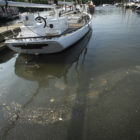Environmental Health
Wildfire Smoke Likely To Have Increasing Impact On Health Of Those Already At Risk
|
Connecticut’s weather on May 25, 2016, was hotter than usual for that time of year, reaching a high of 91 degrees. The winds were out of the northwest at about 10.5 mph and state air pollution officials weren’t expecting anything unusual. Then the state’s air pollution monitoring network went ballistic. Ozone sensors across Connecticut began recording “off-the-chart readings,” Paul Farrell, the director of air planning at the Department of Energy and Environmental Protection, recalled. State experts were shocked.

